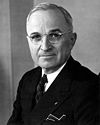- Clinton Presba Anderson
-
Clinton Presba Anderson 
United States Senator
from New MexicoIn office
January 3, 1949 – January 3, 1973Preceded by Carl Hatch Succeeded by Pete Domenici Personal details Born October 23, 1895
Centerville, South DakotaDied November 11, 1975 (aged 80)
Albuquerque, New MexicoPolitical party Democratic Spouse(s) Henrietta McCartney Alma mater Dakota Wesleyan University
University of MichiganReligion Presbyterian Clinton Presba Anderson (October 23, 1895 – November 11, 1975) was an American Democratic Party politician who served as a U.S. Congressman from New Mexico (1941–1945), as the United States Secretary of Agriculture (1945–1948), and as a U.S. Senator from New Mexico (1949–1973).
Contents
Early life and career
Anderson was born in Centerville, South Dakota, on October 23, 1895. He was educated in the public school system of South Dakota, attended Dakota Wesleyan University 1913-1915, and the University of Michigan 1915-1916, though he never received a degree from either institution.
After his father broke his back in 1916, Anderson left the University of Michigan to go home to help support his family. He worked for several months for a newspaper in Mitchell, South Dakota, until he became seriously ill with tuberculosis. He was not aware of his illness until he attempted to join the military in 1917 upon America's entrance into World War I.
Doctors gave him six months to live. One gave him the advice to check himself into the Methodist Sanitarium in Albuquerque, New Mexico. He promptly did so, and while recovering there, occasionally wrote for the Herald of the Wells County.
In 1919, as soon as he was well enough to leave the sanitarium, he gained employment with the Albuquerque Journal, then called the Albuquerque Morning Journal, and was sent to Santa Fe, New Mexico to cover the State's legislature. Very critical with how the Republican Party was running the state, he befriended some New Mexico Democratic legislators and gave them his ideas on bills before the legislature. Some of those ideas eventually became state law and Anderson began a lifelong association with the Democratic Party.
His long career of public service began as Executive Secretary of the New Mexico Public Health Association in 1919. There he raised money to fight tuberculosis, established county health programs and was instrumental in founding the state public health department.
In the early 1920s Anderson pursued private business affairs. Newspaper work seemed to offer a poor future, so in 1922 he started in the insurance business of the New Mexico Loan and Mortgage Company. He was soon able to buy the business and change the name to the Clinton P. Anderson Agency, a successful and enduring enterprise. Actively involved in the Rotary Club of Albuquerque since 1919, he was elected to the International Board in 1930 and became president of Rotary International in 1932, a position that introduced him to many business and political contacts.
Anderson returned to public life, becoming Chairman of the New Mexico Democratic Party in 1928, and being appointed State Treasurer of New Mexico in 1933. That was followed by appointments as director of the Bureau of Revenue, Relief Administrator for the State of New Mexico, Western States Field Coordinator for the Federal Emergency Relief Administration, State Director of the National Youth Administration, Chairman of the New Mexico Unemployment Security Division, and Managing Director of the Coronado Cuarto Centennial Commission, among others. It was Anderson's style to take on a newly created position or an emergency situation, organize it, and then leave when he felt that all was running smoothly.
In 1940, a conflict among members of the state Democratic Party resulted in Congressman John J. Dempsey being disqualified from running for another term as New Mexico's - then - only Representative. Party members convinced Anderson to run for the seat - which he won. Utilizing his many business and political contacts throughout the state Anderson won the election. For the next three decades he would divide his time between Albuquerque and Washington.
Anderson became known for his thorough investigative work and during his three terms in the House of Representatives, was assigned to several special committees, including the chairmanship of the Special Committee to Investigate Food Shortages in 1945. The committee argued for a streamlined food distribution system and emphasized long-range planning for increasing food production. It was his success in that assignment, along with their personal friendship, that led to his appointment by Harry Truman as Secretary of Agriculture.
Truman Administration
Shortly after Harry S. Truman became President in 1945, he selected Anderson to serve as his Secretary of Agriculture. His most immediate concern was the reorganization of the domestic agricultural economy, which for the previous four years, had been focused on supporting the American war effort in the Second World War. Anderson addressed issues such as price controls, shortages, and subsidies, and he played an important role in developing post-war agricultural policies.
The domestic situation was only one of Anderson's concerns as Secretary of Agriculture. The looming worldwide food crisis, which was becoming more evident by 1946, led President Truman to establish the Famine Emergency Committee.
Anderson made two controversial moves to change the drastic problems. First, utilizing his organizational skills, he incorporated all existing food and agricultural activities under his office. Second, he advised Truman to enlist former President Herbert Hoover to serve as chairman of the Famine Emergency Committee. During this crisis, Anderson, Truman, and Hoover worked together very closely. Many of Hoover's proposals on alleviating the international food shortage were adopted by the Truman administration and it became Anderson's responsibility to implement these proposals. These three men can be credited with preventing an even larger international disaster.
U.S. food production and world wide distribution was stabilized by 1948 and Anderson decided to retire from the Cabinet. As with every project he had undertaken, Anderson only stayed until he had resolved the problems it faced.
Senate career
Election
Anderson considered retiring altogether after resigning from the cabinet. However, State Democrats, led by the retiring Senator Carl Hatch convinced Anderson to run for Hatch's seat against the formidable and distinguished diplomat Patrick J. Hurley.
These two well-established candidates faced off in one of the most heated campaigns of the 1948 election. Due to the nationwide campaigning of the Truman administration against an 'obstructionist' Republican Congress, Republicans lost across the country, including Hurley.
His re-election in 1954 against former Governor of New Mexico Edwin L. Mechem would be less heated, but more significant due to the Democrats losing the Senate the previous year. But Anderson prevailed and went on to be re-elected by wide margins in 1960 and 1966.
Accomplishments
Anderson's main accomplishment as a Senator was being one of the most outspoken proponents of the Space Program. He was instrumental in gaining funding for the program while Chair of the Senate Committee on Aeronautical and Space Sciences from 1963-1973. As Chair of the committee during the most active period of space exploration, and the most important time of the Space Race, Anderson held a key policy making role in Washington—not to mention the purse strings for NASA.
Anderson is also known for the Price-Anderson Nuclear Industries Indemnity Act.
He also served as Chair of the Joint Committee on Atomic Energy (84th and 86th Congresses), Joint Committee on Construction of Building for Smithsonian (84th-92nd), Joint Committee on Navaho-Hopi Indians (84th-92nd), Special Committee on Preservation of Senate Records (85th and 86th, Committee on Interior and Insular Affairs (87th and 88th), Special Committee on National Fuel Policy (87th).
During his tenure, he was admired for accomplishing exactly what he had been doing for much of his life; devoting himself to any cause he thought important. And, even if he knew little on the subject, his determination to fix a problem and to progress society as a whole. Some believed Anderson was a strong possible Democratic Candidate for President in 1968 - something which never materialized due to his age.
Due to his age and growing health problems, he retired in 1973 after serving four terms in the Senate. He died in Albuquerque on November 11, 1975, and is interred at Wyatt Gross Memorial Park.
In the 1998 HBO miniseries From the Earth to the Moon, Anderson was played by Mason Adams.
References
External links
- Clinton P. Anderson Papers, 1848-1975, University of New Mexico, Center for Southwest Research
- Clinton P. Anderson Papers, 1945-1948, Harry S. Truman Library
Political offices Preceded by
Claude R. WickardUnited States Secretary of Agriculture
Served under: Harry S. Truman
1945–1948Succeeded by
Charles F. BrannanUnited States Senate Preceded by
Carl HatchUnited States Senator (Class 2) from New Mexico
1949 – 1973
Served alongside: Dennis Chavez, Edwin L. Mechem, Joseph MontoyaSucceeded by
Pete V. DomeniciBusiness positions Preceded by
Sydney W. PascallPresident of Rotary International
1932-1933Succeeded by
John NelsonUnited States Secretaries of Agriculture 
Cabinet of President Harry S. Truman (1945–1953) Vice President 
Secretary of State Edward Stettinius, Jr. (1945) • James F. Byrnes (1945–1947) • George Marshall (1947–1949) • Dean Acheson (1949–1953)Secretary of War Secretary of Defense James Forrestal (1947–1949) • Louis Arthur Johnson (1949–1950) • George Marshall (1950–1951) • Robert A. Lovett (1951–1953)Secretary of the Treasury Attorney General Francis Biddle (1945) • Tom C. Clark (1945–1949) • J. Howard McGrath (1949–1952) • James P. McGranery (1952–1953)Postmaster General Secretary of the Navy Secretary of the Interior Secretary of the Agriculture Secretary of Commerce Secretary of Labor United States Senators from New Mexico Class 1 
Class 2 Members of the United States House of Representatives from New Mexico Territorial (1851–1912) At-large seats (1912–1969) SeatSeatDistricts (1969–present) 1st district2nd district3rd districtCategories:- Truman Administration cabinet members
- 1895 births
- 1975 deaths
- American Presbyterians
- Members of the United States House of Representatives from New Mexico
- People from Turner County, South Dakota
- United States Secretaries of Agriculture
- United States Senators from New Mexico
- United States vice-presidential candidates, 1956
- University of Michigan alumni
- Democratic Party United States Senators
- New Mexico Democrats
Wikimedia Foundation. 2010.

